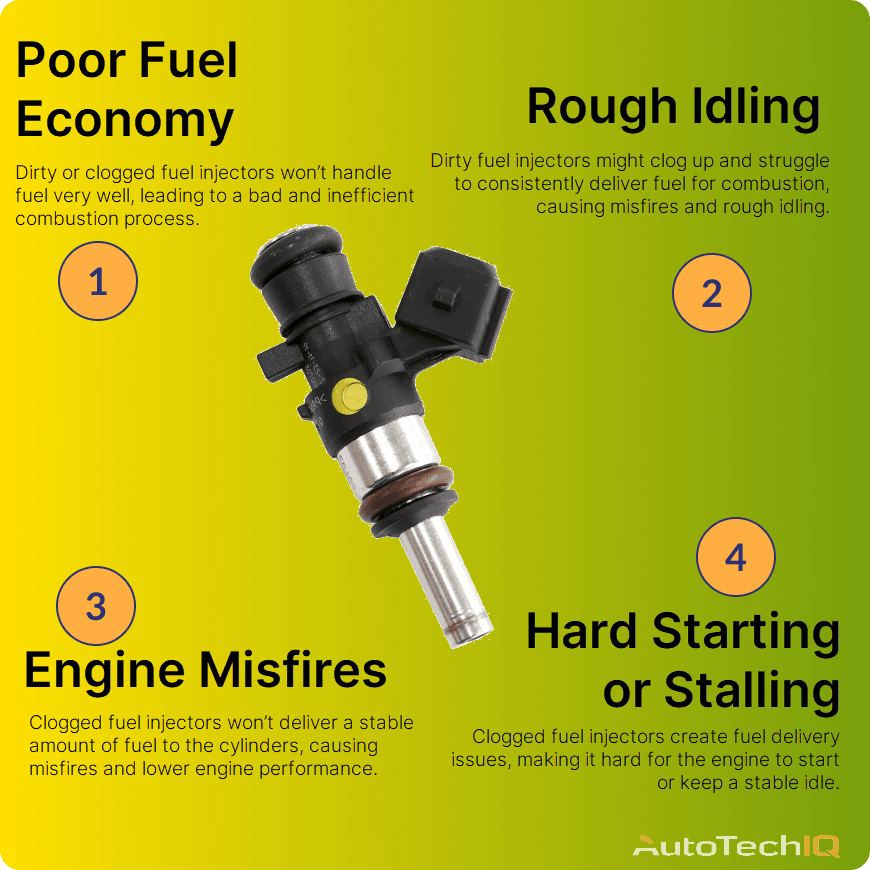What Are the Steps to Diagnose Fuel Injector Issues?
In diagnosing fuel injector issues, start by testing the fuel injectors for proper functioning using a fuel injector tester. Then, check the injector for clogging or leaking, and inspect the wiring and electrical connections for any faults.
Diagnosing fuel injector issues is crucial to maintaining the efficiency of your vehicle’s engine. By identifying and resolving these issues, you can improve fuel economy, reduce emissions, and enhance overall performance. Proper diagnosis involves testing the injectors, inspecting for clogging or leaks, and ensuring the integrity of the electrical connections.
Whether it’s a decrease in engine power, rough idling, or increased fuel consumption, understanding and addressing fuel injector problems is essential for maintaining your vehicle’s optimal functionality. Let’s delve into the steps involved in diagnosing and resolving fuel injector issues.
.jpeg)
Credit: www.lexbrodies.com
Importance Of Fuel Injector Diagnosis
Diagnosing fuel injector issues is crucial for optimal engine performance. The steps involve checking for fuel leaks, inspecting injector connections, and testing injector pulse using a stethoscope or diagnostic tool. Identifying and addressing fuel injector problems early can prevent costly repairs and ensure efficient fuel delivery.
Importance of Fuel Injector Diagnosis Fuel injectors play a crucial role in the efficient functioning of a vehicle’s engine. Identifying and diagnosing potential issues with fuel injectors are essential to maintain optimal engine performance. Ignoring early signs of fuel injector problems can lead to costly repairs and damage to the engine. Therefore, understanding the importance of fuel injector diagnosis is critical for the longevity of your vehicle. Identifying Early Signs Early signs of fuel injector issues can be subtle but should not be overlooked. Symptoms such as rough idling, decreased fuel efficiency, and engine misfires can indicate potential problems with the fuel injectors. By paying attention to these signs and conducting regular inspections, you can catch issues early and prevent further damage to the engine. Preventing Engine Damage A proactive approach to fuel injector diagnosis is crucial in preventing extensive engine damage. Regular fuel injector inspections and maintenance can help identify and rectify issues before they escalate. By addressing fuel injector problems promptly, you can avoid costly repairs and ensure the longevity of your vehicle’s engine. In essence, understanding the early signs of fuel injector issues and the importance of regular diagnosis can save you from major engine damage and costly repairs. By staying proactive and conducting regular inspections, you can maintain optimal engine performance and prolong the lifespan of your vehicle.Common Symptoms Of Fuel Injector Issues
Fuel injector issues can have a significant impact on the performance of your vehicle. Recognizing the common symptoms of fuel injector issues can help you diagnose and address the problem before it escalates. Here are the common symptoms to watch out for:
Engine Misfires
One of the most telltale signs of fuel injector issues is engine misfires. When the injector fails to deliver the proper amount of fuel to a specific cylinder, it can cause the engine to misfire. This results in a noticeable jolting or shaking sensation during acceleration or idle. In addition, it can lead to a decrease in power and overall performance of the engine.
Decreased Fuel Efficiency
Another symptom of fuel injector issues is a noticeable decrease in fuel efficiency. Due to the improper fuel delivery, the engine may compensate by consuming more fuel than necessary, resulting in reduced miles per gallon. You may also notice an increase in fuel odor as the unburned fuel is expelled through the exhaust system.
Diagnostic Process
To diagnose fuel injector issues, a systematic Diagnostic Process is essential. This process involves using various tools and tests to pinpoint the root cause of the problem.
Using Obd-ii Scanner
An OBD-II scanner is an invaluable tool that can quickly identify potential fuel injector issues by scanning the vehicle’s onboard computer for error codes.
Fuel Injector Balance Test
A Fuel Injector Balance Test involves analyzing the performance of each fuel injector to ensure they are delivering the correct amount of fuel to the engine.

Credit: www.gbreman.com
Visual Inspection Of Fuel Injectors
When it comes to diagnosing fuel injector issues, a visual inspection is an essential step in determining potential problems. By visually examining the fuel injectors, you can identify leaks and build-up that may be affecting their performance. In this section, we will look at two critical aspects of the visual inspection process: checking for leaks and inspecting for build-up.
Checking For Leaks
During the visual inspection, it is crucial to check for any visible signs of fuel leaks from the fuel injectors. Leaking fuel injectors can result in decreased fuel efficiency and engine performance issues. To check for leaks, follow these steps:
- Start by wearing protective gloves and eyewear to ensure your safety throughout the inspection.
- With the engine turned off, open the hood and locate the fuel injectors. They usually appear as small cylindrical devices attached to the intake manifold.
- Inspect each fuel injector individually, paying close attention to the connections, seals, and fittings.
- Look for any signs of fuel pooling or dampness around the fuel injectors or the areas where they connect to the fuel rail.
- If you notice any leaks, it is crucial to address the issue promptly by replacing the faulty injector or repairing the affected components.
Inspecting For Build-up
Another critical aspect of the visual inspection process is checking for build-up on the fuel injectors. Over time, deposits of dirt, carbon, and debris can accumulate on the injector nozzles, impeding their performance. Follow these steps to inspect for build-up:
- Once again, ensure you are wearing protective gloves and eyewear.
- With the engine turned off, locate the fuel injectors.
- Examine the injector tips for any signs of build-up or clogging. Pay attention to the small openings where fuel is sprayed into the combustion chamber.
- If you notice any build-up, it is important to clean the fuel injectors thoroughly.
- Consider using a fuel injector cleaner or taking your vehicle to a professional mechanic for a more thorough cleaning procedure.
By visually inspecting the fuel injectors and checking for leaks and build-up, you can gather valuable information about their condition. Remember, proper maintenance and timely repairs are crucial in ensuring optimal fuel injector performance and the overall efficiency of your vehicle.
Final Steps In Diagnosis
To diagnose fuel injector issues, the final steps involve conducting a thorough inspection of the injectors for clogs or leaks. Additionally, performing a fuel pressure test and examining the electrical connections can help to pinpoint any potential problems. This process allows for a comprehensive diagnosis of fuel injector issues.
After testing the fuel pressure and inspecting the wiring connections, there are a few final steps you can take to further diagnose fuel injector issues. These steps can help you pinpoint the exact problem and determine the best course of action for repair.Testing Fuel Pressure
One of the crucial final steps in diagnosing fuel injector issues is to test the fuel pressure. This test helps determine if the fuel injector is delivering fuel to the engine at the right pressure. To conduct this test, follow these steps:- Attach a fuel pressure gauge to the fuel rail of the engine.
- Start the engine and let it idle while monitoring the fuel pressure.
- Compare the recorded pressure with the manufacturer’s specifications.
Inspecting Wiring Connections
Another important step in the diagnosis is inspecting the wiring connections related to the fuel injector. Faulty or loose connections can cause issues with the injector’s functionality. Here’s how you can inspect the wiring connections:- Visually examine the wiring harness and connectors for any signs of damage, corrosion, or loose connections.
- If you find any issues, repair or replace the damaged wiring or connectors.

Credit: www.autotechiq.com
Frequently Asked Questions On What Are The Steps To Diagnose Fuel Injector Issues?
How Do You Diagnose A Fuel Injector Problem?
Diagnosing fuel injector problems involves using diagnostic tools to check for irregular fuel spray, vacuum leaks, and fuel pressure. Inspecting for faulty electrical connections and performing a cylinder balance test can also help identify issues. Consulting a professional mechanic is advised for accurate diagnosis and repairs.
What Is The Best Test To Find A Bad Injector?
The best test to find a bad injector is a fuel injector flow test. This test measures the flow rate of each injector to determine if any are malfunctioning.
What Is The Correct Procedure For Fuel Injector Inspection?
To inspect fuel injectors correctly, follow these steps: 1. Turn off the engine and relieve fuel pressure. 2. Disconnect the fuel rail and remove the injectors. 3. Inspect for signs of clogs, leaks, or damage. 4. Check the injector spray pattern against manufacturer specifications.
5. Clean or replace any faulty injectors as needed.
How Do Mechanics Test Fuel Injectors?
Mechanics test fuel injectors by performing a fuel injector flow test. They connect a specialized tool to the injectors, then measure and compare the amount of fuel each injector sprays. This helps identify any issues with flow or unevenness that may affect engine performance.
Conclusion
Diagnosing fuel injector issues is crucial for optimal vehicle performance. By following these steps, you can identify and resolve problems effectively. Regular maintenance and professional inspections can prevent costly repairs down the line. Stay proactive and address any issues promptly to keep your vehicle running smoothly.

